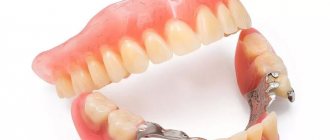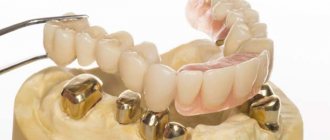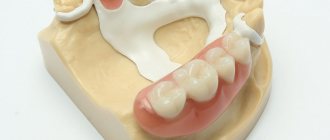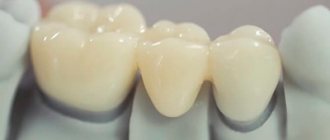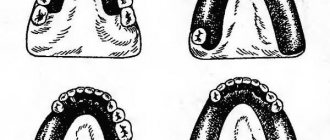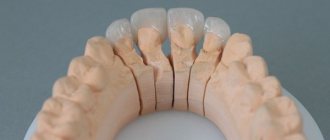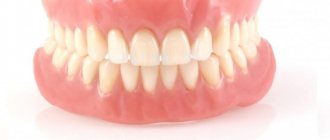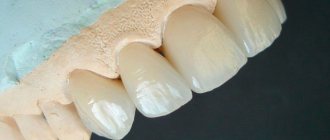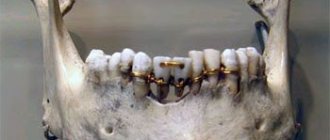Clasp dentures, popular in prosthetics, are not a new technology at all. The first development was proposed by a German doctor at the beginning of the last century. Hence the name. Bugel means “arc” in German.
This type of prosthesis is distinguished by its strength, reliability and durability. The design includes an arch on which artificial teeth are attached, a saddle (bridle), a base and a mount for supporting teeth. This structure ensures reliable fixation of the product in the oral cavity. Used to restore teeth with partial edentia.
In addition to reliability, the clasp denture preserves the functionality of the dentition and evenly distributes the load on the jaw. The design has a high level of aesthetics and does not cause discomfort when worn. The absence of a bulky base saves the patient from constant cleaning of the product. In addition, the prosthesis does not need to be removed at night. Let's talk about the nuances and types of products.
Classification
Clasp structures refer to a removable or conditionally removable method of prosthetics. They are divided by type of material and type of fastening. The base of the prosthesis, the arch, is made of three types of material:
- Made from medical alloy (cobalt, chromium).
- Noble metals (gold-platinum).
- Plastics.
It is obvious that metal-free clasp dentures are less durable, wear out quickly and break under load. However, it is an inexpensive alternative for patients with high sensitivities and metal allergies.
A more durable option is made from an alloy of gold and platinum. Also suitable for patients with allergies, but costs several times more.
Manufacturing stages
This type of prosthesis is quite labor-intensive to manufacture. The process takes a long time, it includes the following laboratory steps:
- Making a plaster cast. Thanks to this, you can choose the right design taking into account individual characteristics.
- Determination of bite and jaw position in three cavities.
- Carrying out measurements of the load on the supporting teeth.
- Creating a drawing of a prosthesis on a model. This allows you to determine design features.
- Grinding teeth on a model..
- Creating a plaster prototype using a cast. .
- Frame casting, grinding and polishing. At this stage, a wax model and a special alloy are used.
- Installation of artificial teeth on a wax roller. This is done in order to obtain their fingerprint. .
- Preparation of a wax model impression, which is then poured.
Mounting type
Fixation of clasp dentures is carried out due to the patient’s neighboring (healthy) teeth, which are used as a support. The structure can be fixed:
- Using locks. The upper part of the lock is placed inside the artificial teeth, and the lower part is in a metal crown, which is installed on the supporting teeth. This provides additional protection and reliability to your own teeth. And evenly distributes the load on the supporting teeth. Externally, the prosthesis looks very neat and aesthetically pleasing. And it can be easily removed if necessary. The disadvantage of the product is its high cost due to the use of additional materials.
- Hooks (clasps). The most affordable and simple fixation system. The hook grips the abutment tooth. The cast design and metal clasp guarantee high-quality fasteners and a tight fit to the tooth. Each hook is produced in accordance with the size, shape and anatomical features of the abutment tooth. Therefore, accidental loss of the structure from the mouth is excluded. The downside is that the hooks may be visible in the mouth. For example, when talking or eating.
- The third type of fixation is telescopic crowns. In this case, two crowns are used. The first is installed on the supporting dental unit. The second is inside the prosthesis. The size of both crowns is calculated so that the outer one fits tightly onto the inner one.
The last type of fastener is considered the most optimal. Even if the supporting tooth is destroyed, the inner crown will hold the denture. The adjustment will be minor. However, the development of a clasp prosthesis with telescopic fixation requires highly qualified specialists. Both a doctor and a dental technician.
What is clasp prosthetics and when is it prescribed?
Clasp prosthesis is one of the types of prosthetic systems, which consists of an arched removable structure. Removable dentures are considered the most practical. They are very comfortable to wear and have very little chance of rejection. Dentures are functional and easy to care for.
The main advantage of a clasp denture is the supporting element in the structure, which adapts to any jaw size, bite and other anatomical features. The arch firmly connects the two sides of the jaw, making it possible to restore both lateral and front teeth as a whole. The frame of the prosthesis is made of metal, and the teeth themselves are made of ceramics.
Clasp prosthetics are prescribed in the following cases:
- Absence of a large number of teeth (from three at the edges and from four in the middle of the dentition). If one or two teeth are lost, prosthetics are not advisable; an implant is inserted into the dentition.
- Complications from periodontitis, when the gums do not adhere tightly to the teeth, resulting in loosening of the teeth. Dentures act as a stabilizer and strengthen the dentition to avoid tooth loss.
- Rapid wear of teeth due to improper load on the row, or in case of serious dentin disease.
- Grinding teeth in sleep.
- Correction of malocclusion in the absence of teeth.
pros
Unlike soft removable dentures, arch structures do not rub the gums and do not cause long-term addiction. Due to the tight fixation, the mobility of the product in the mouth is eliminated. The structure of the prosthesis does not block the palate - this preserves taste sensations during meals. In addition, the clasp denture does not block the movement of the tongue in the mouth. This does not distort diction and does not cause spasms of the facial muscles.
The distribution of load during chewing of food occurs according to the “one to two” principle. That is, one-third of the pressure is on the support unit and two-thirds on the beam system. The arc takes away part of the load, which protects soft tissues from damage and deformation. In classic removable dentures, the chewing load is directed to the gums and palate.
The structural features of the clasp prosthesis determine its shelf life. With proper care, the product will last at least 7 years, while soft prostheses provide functionality for up to 5-6 years. In the absence of a frame in soft removable dentures, the prosthetic bed quickly collapses.
Another advantage of the design is the possibility of parallel dental treatment with a prosthesis installed. Such products are called splinting - they simultaneously replace missing teeth and tightly fix existing ones.
Clasp dentures: types, indications and contraindications for installation
Choosing clasp dentures: 3 main types and their features
A clasp denture is a structure consisting of a frame, an acrylic lining (imitates gums) and artificial teeth. Its base can be made of metal, nylon or acetal (depending on the type). Prostheses also differ into 3 types according to the method of attachment. Each of them is characterized by certain properties and is selected for its intended purpose.
Advantages of the method
In modern dentistry, clasp prosthetics is one of the most popular and effective alternatives to dental implantation. This technology solves aesthetic and practical problems, eliminates defects and restores the beauty of a smile. Its main advantage is practicality, which is expressed in a number of characteristics of clasp dentures:
- reliability of fastening in the mouth;
- Possibility of use with a small number of natural teeth;
- durability. The service life is 5–10 years (depending on the conditions of use and attitude towards the prosthesis);
- comfort. The design does not cover the sky and is characterized by compact size and thickness (compared to plastic analogues). Absolutely does not interfere with the mouth, does not interfere with diction;
- Possibility of round-the-clock use;
- naturalness. Crowns skillfully imitate real teeth and do not attract unnecessary attention when talking or smiling;
- exception of correction.
At the same time, the orthopedic design is removable, which makes it easier to care for. The frame of the prosthesis is strong and durable, the load during chewing is distributed evenly. This reduces pressure on specific teeth and eliminates the risk of damage to the gums or mucous membranes.
Indications for use
The first and main thing is the need to restore the dentition, solve aesthetic and functional problems. Also among the indications for the use of clasp dentures it is worth noting:
- the need to correct curvature;
- splinting during treatment of periodontal disease;
- replacement of teeth (one or more).
Clasp structures are installed not only on the lower, but also on the upper jaw, as well as if it is necessary to eliminate one- or two-sided end defects. From all that has been said, we can conclude about the practicality and versatility of the designs.
Contraindications for installation
Despite a number of significant advantages and versatility, there are certain points that prevent the use of clasp dentures. The main contraindications include:
- systemic diseases in the acute phase;
- inflammation in the oral cavity;
- lack of teeth to support the prosthesis.
The final decision on the possibility of installation is made by the doctor, taking into account the patient’s problems.
Stages and nuances of manufacturing
Clasp dentures are made for each specific patient in accordance with the parameters and characteristics of his jaws. They are produced in laboratory conditions. The process consists of several successive stages. The stages of manufacturing clasp dentures include:
- Taking an impression of the jaw, after which it is sent to the laboratory, where the structure is produced.
- Casting a prosthesis from marble plaster. The model is made in exact accordance with the print.
- Applying a frame drawing to the model.
- Manufacturing of the structure.
- Frame casting, grinding and polishing.
- Installation of the structure on the workpiece.
- Modeling with wax. At this stage, “teeth” of the desired size and shape are selected.
- Frame fitting by the patient.
- Replacement of wax models of teeth with plastic ones. The final steps for processing the prosthesis are carried out.
- Installation in the oral cavity.
The manufacturing technology of the structure is carried out in two ways. The first is casting from a wax model, which is made according to a plaster model. The resulting prosthesis is then covered with a fire-resistant material. Next, the wax is melted down and metal is poured in instead.
The second method is based on casting the structure from a fireproof model. Then they make a frame arc from wax. This method is characterized by a number of advantages, in particular, the prosthesis does not lose its original shape, is lightweight and exactly matches the anatomy of the gums, which makes it easier to get used to.
Features of preparation for prosthetics
Manufacturing and installing clasp structures is a difficult process that involves a lot of nuances. If even one tooth needs to be removed, the prosthesis will have to be completely redone, which entails additional costs for the patient. Therefore, before installation, a complete refurbishment is carried out, all problems are eliminated. In particular, teeth with signs of inflammation in the periapical tissue are removed, caries is filled, plaque and stone are removed, and periodontitis is treated.
Movable teeth (grade 3-4) are also removed. If the supporting incisors do not have natural recesses for fastening clasps (prosthesis hooks), then special inlays of the required shape are made. The problem may also be a poorly defined equator. In this case, a crown of a suitable shape is attached to the tooth.
When occlusal curves are disturbed, orthodontic realignment methods are undertaken. Sometimes the problematic incisor is depulped.
When it is planned to install an implant, it is first made, and after osseointegration is completed, prosthetics with clasp structures are performed.
Main varieties
The designs differ in the principle of fastening. According to this parameter, the following types of clasp dentures are distinguished:
- With clasps (metal hooks). They are attached next to the neck of the supporting tooth close to the gums. Due to this fixation, the prosthesis does not move, and chewing pressure is transferred to the supporting incisors. These models are the most affordable. The disadvantage of such designs is the obvious visibility of the clasps and their micro-mobility, which leads to damage to the enamel. The problem can be solved by installing metal-ceramic crowns on the supporting teeth.
- With attachments (clasps). The clasp is fixed on the supporting teeth using miniature mechanisms. A prosthesis with locks leads to increased pressure on the jaw, so the natural incisors are protected and strengthened with the help of crowns. The fastenings are located on the rear of the structure. They securely fix the prosthesis and are difficult to notice in the mouth.
- With telescopic crowns. This is the most modern type of construction. Fixation of clasp dentures is carried out on natural teeth using crown caps. Their upper part is removable, unlike the lower part, which is fixed. If necessary, the matrix can be changed.
If it is not possible to fix the structure on the supporting teeth, it is necessary to strengthen the loose ones, then special splinting clasps are used. They are equipped with several links, claw-like processes or rings. Such fasteners securely fix each tooth.
Subtleties of caring for clasp structures
The main measures boil down to careful personal hygiene. You need to take care of clasp dentures regularly. After each meal you should rinse your mouth and brush it 2 times a day. Do not use abrasive pastes or compositions with a bleaching effect.
Also, once a day you need to use products that protect the structure from corrosion and remove antibacterial plaque. To do this, the prosthesis must be placed in a special composition for 5–10 minutes. It is imperative to undergo a preventive examination at the dentist every 6 months.
Note that clasp structures are a practical and one of the most affordable prosthetic technologies. However, it only works in certain cases, so it is in the interests of the patients themselves not to neglect their oral health. If you need to replenish your teeth, you shouldn’t delay it; you need to see a doctor as soon as possible.
Minuses
The choice of material and fastening can affect the price of the orthopedic structure. The cost can increase 2-3 times compared to analogues.
For metal clasp dentures, there remains a risk of allergies. In addition, the prosthesis cannot be used to restore the entire dentition. To fix the prosthesis, healthy supporting teeth are needed. An alternative is to install implants as support units.
The risk of receiving a low-quality product in the case of arc structures is also very high. You need to carefully choose specialists and a dental clinic for prosthetics.
If there are no outer teeth in the row, the process of fixing the prosthesis becomes more complicated. The structure only needs to be secured on one side. The locking method of fastening ensures good stability of the clasp denture in the mouth. However, the risk of spontaneous displacement still remains (end defect).
Alternative methods of dental prosthetics
None of the methods can be considered universal. Clasp dentures have disadvantages and have contraindications. In such situations, the orthopedist will choose another method for you. Our clinic uses different methods. An alternative to clasp dentures can be:
- Acri Free prostheses. They are highly comfortable while wearing. Unlike clasp prosthetics, Akri Free can be used even with complete edentia. Another advantage of these structures is their high aesthetics. It is achieved due to the fact that soft and elastic plastic is used to make the gingival part.
- Acrylic dentures. Such orthopedic structures are distinguished by their low price. Traditional acrylic products are characterized by low strength and service life. We offer dentures made of acrylic with the addition of diamond chips. This design solution allows us to produce strong, durable and aesthetic products.
- On locks or attachments. Suitable if healthy tooth roots are preserved. The prosthesis is attached to its own roots using fixing locks. The service life of such prostheses depends on the condition of the supporting roots.
These methods of dental prosthetics allow you to restore the integrity of the dentition and return the patient to a healthy and beautiful smile. But compared to them, clasp dentures have a serious advantage - a splinting effect. If there is a need to preserve your own teeth, which have already begun to loosen, clasps are the best option.
Removable dental prosthetics has another disadvantage that must be taken into account when choosing a method. None of the removable dentures can provide an even load on the gums. As a result, bone tissue gradually atrophies. To avoid it, it is better to install fixed or conditionally removable dentures on implants. This approach allows us to ensure the physiological functioning of the dental system. Modern implantation methods make it possible to restore the dentition in 3-5 days; there are types of implants that can be implanted even when bone loss has begun.
Contraindications
Clasp structures are not used in cases of complete edentia and the absence of outer teeth in a row. The presence of inflammation in the root canals of supporting teeth may delay the installation of a clasp denture for treatment. If the inflammation is not eliminated, it can lead to tooth loss. And, as a result, to replacing the prosthesis.
Limitations for installing a prosthesis also include incorrect bite, severe abrasion of the enamel, and allergies to the materials used.
For high-quality fixation of the structure in the oral cavity there must be at least 6 healthy teeth in the upper and lower jaw. Otherwise, you will have to choose another prosthesis or supplement the series with implants.
When you can’t install a clasp prosthesis
Despite the fact that clasp dentures are often used, there are a number of contraindications to their installation:
- Diseases associated with the oral cavity and in the acute stage;
- Increased abrasion of teeth;
- Diseases associated with bone loss;
- Complete absence or low position of supporting teeth;
- Bite too deep;
- Chronic diseases of a nervous and mental nature;
- Defects in the development of the frenulum of the tongue;
- Small depth of the oral cavity;
- Individual intolerance to prosthetic materials, allergies.
Design development
Like most types of prosthetics, the manufacture of a clasp prosthesis consists of two stages: preparation for installation and production of the structure.
It all starts with a thorough diagnosis of the patient’s jaw. The initial examination is complemented by an x-ray examination, which determines the condition of the teeth and root canals. It also shows the presence of pathologies in both jaws. In more complex cases, EspaDent clinic specialists use a modern 3D tomograph with layer-by-layer images of the jaw. During the diagnosis, the doctor also checks for allergic reactions to the materials used. Based on the clinical situation, wishes and capabilities of the patient, the dentist selects a suitable prosthesis.
The preparatory stage for installing a clasp prosthesis includes:
- Sanitation (cleaning) of the oral cavity.
- Elimination of carious cavities and inflammatory processes in supporting teeth.
- Grinding of teeth and fixation of crowns (for locking and telescopic structures).
Treatment of supporting teeth can cause discomfort, so the procedure is carried out using local anesthesia - safe and painless.
In order for the dental technician to begin making the partial denture, the doctor takes impressions of the prepared jaw. Then follows the calculation part, on the basis of which the specialist creates a wax model of the clasp. The sample is used to produce a metal arch onto which a temporary base and new teeth are installed.
The intermediate product is given for fitting. The patient evaluates the convenience of the design, the reliability of fixation in the oral cavity, and the level of comfort when moving the jaw. If necessary, the prosthesis is adjusted and then the final version is made. In the production of the base, artificial gum, plastic or nylon is used.
After installation, the doctor gives recommendations on how to care for the product. The process takes 3-4 weeks. The time frame may extend due to the need for preliminary dental treatment.
Design nuances for both jaws
The structure of the prosthesis depends on the installation site. For example, a clasp denture is installed on the upper jaw using locks and clasps (hooks). The first method is more popular because... In addition to fixation, the locks provide high-quality support during chewing loads. The hidden fastening mechanism of lock-type prostheses ensures high aesthetics and does not interfere with eating.
Indications for installing a prosthesis on the upper row is the impossibility of implantation. And also the so-called “flat palate” syndrome - atrophy of the alveolar processes.
Unlike the upper row, the clasp denture on the lower jaw can be attached in any of the available ways. The difference between the designs is the location of the arc and fixing elements. In an upper denture, the arch may be located in front or in the middle of the palate. There is also a difference in the shape of the arc: in the form of a jumper, a ring or a crescent.
Construction of a clasp prosthesis
Clasp dentures for teeth have 3 components:
- Arc (clasp) . It is made from certain metal alloys such as cobalt-chromium, platinum-containing and gold-containing metal. There are also dentures made of plastic. The shape of the arch is formed taking into account: the type of jaw, bite, development of the palatal vault and the number of lost teeth.
- The basis. The artificial gum is located on both sides of the arch. Can be made of plastic or nylon.
- Artificial teeth. They are made mainly of plastic, but there are also metal-ceramics and zirconium.
Before making a clasp denture, an impression of the patient’s teeth is taken to form a natural bite.
Care Tips
Any orthopedic structure will last longer if it is properly cared for. General recommendations for clasp dentures are simple:
- Clean your dentures regularly and thoroughly with a toothbrush.
- Rinse the structure after eating food.
- Periodically remove and soak the product in a special solution. Each structure has its own frequency at which the structure can be removed so as not to damage it. The doctor tells the patient about the peculiarities of care after installing the clasp prosthesis.
To avoid damaging the surface of the crowns, it is not recommended to use whitening pastes or too hard toothbrushes. It is also important to visit the dentist 1-2 times a year for preventive procedures.
Caring for clasp dentures
In order for your prosthesis to serve you for a long time, you need to properly care for it. This does not require complex manipulations.
Basic advice from our dentists when wearing a partial denture:
- The denture must be cleaned with toothpaste together with healthy teeth;
- After eating you need to rinse your mouth with water;
- Once every 2 days, the plates must be placed in a disinfectant solution;
- You need to store the prosthesis in a special case, after washing and drying it;
- Do not overload the denture with too hard food;
- You need to learn to chew food with your lateral teeth on both sides.
What not to do when wearing a partial denture:
- Expose dentures to high temperature, chemical and mechanical damage;
- Use abrasive toothpaste: it leads to oxidation of the metal base of the dentures;
- Drink coloring drinks.
